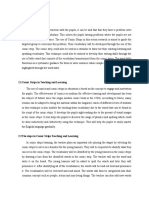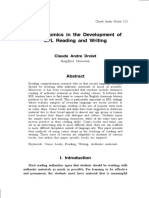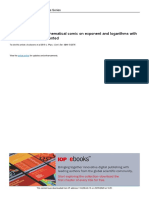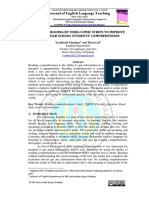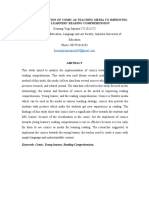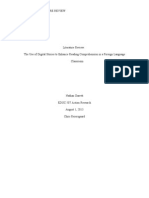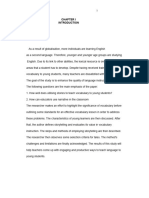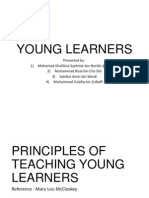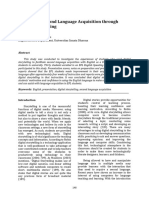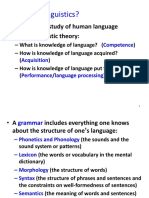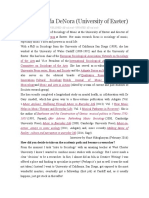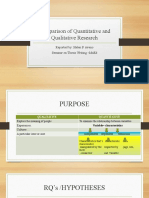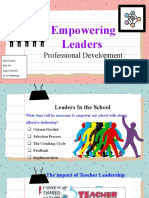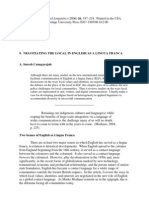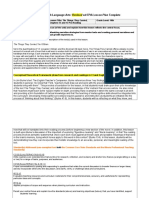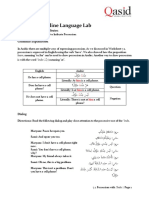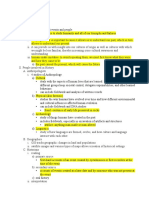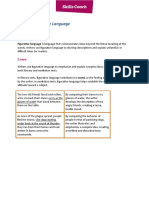Subject:
Effect of Conventional and digital Comic Strips on Iranian Young EFL
Learners Reading Skill and Creativity
Introduction
In the history of education, the teaching of reading has been a principal focus for many years.
Numerous research efforts are evidence of widespread interest in all aspects of the reading
process, especially in the beginning stages of learning to read. Wright and Sherman (1994)
suggests, visuals, especially comics are commonly used to encourage and develop students’
interests and competencies in reading.
A comic strip is a drawing or a collection of multiple drawings that tells a story. As the name
shows, a comic strip can be humorous. There are two types of comics: Conventional and
Digital comics. Conventional comic is a sequence of drawings in boxes that tell a story.
Digital comics (also known as eComics) can refer to either comics created entirely on a
computer or comics released digitally (as opposed to in print).
The recent literature on the use of visuals in reading comprehension has pointed out that the
visual aids can be good teaching tools (Wright and Sherman, 1999), valuable companies for
reading comprehension passages (Liu, 2004), and a fruitful research tool to elicit information
especially for the production of language (Gambrell and Jawitz, 1993). Nevertheless, there
has been little attempt to identify the possible effects of comic strips as a type of visual on
reading comprehension of EFL learners. Considering the theoretical and practical suggestions
in the reading comprehension literature, this study aims to investigate the effects of
conventional and digital comics on Iranian EFL learners' reading comprehension and
creativity.
1
�Statement of problem
Reading should be an active and fluent process in learning another language. Often, however,
it is not. All learners who experience reading difficulties have comprehension problem. For
many young learners, these comprehension problems might arise because of inaccurate or
inefficient decoding and word recognition processes. Moreover, motivational factors also
affect comprehension. This is because some young learners could comprehend simple word
and sentences but have difficulty understanding longer texts. To make young learners to read
Comic strips due to short sentences and picture accompanied are more attractive and seem
easier to read for young learners. Furthermore, Digital comic strips have more educational
benefits in addition of making reading attractive. They not only make young learners
interested in reading but also make them enthusiastic to learn vocabulary and imperceptibly
force them to check their grammar accuracy.
So, by using Conventional comic strips and Digital comic strips young learner are expected
to be more interested and having less problem in reading and reading comprehension. There
are very little research which has focused on comics that not only improve reading
comprehension but also enhance creativity. Visual illustration such as comics can help EFL
students with comprehension. In addition to pictures, teachers can utilize comics to help
students to make connection between key ideas.
In this study, a new way for teaching and learning reading will be employed by using comics.
However in Iranian school, especially primary school teacher hardly implement comics in
order to teaching reading so the present study will investigate that how conventional and
digital comic strips can improve reading comprehension on Iranian young students.
Objectives of the study
The general objective of this research is to investigate effect of digital and conventional
comic strips on Iranian young learners` reading skill and creativity.
Specific objectives are the following:
1. To investigate effect of digital comic strips on EFL young learner reading
comprehension
2. To investigate effect of conventional comic strips on EFL young learner reading
3. To investigate effect of digital comic strips on EFL young learner creativity
4. To investigate effect of conventional comic strips on EFL young learner creativity
5. Relationship between Iranian EFL learner reading comprehension and creativity
2
�Research questions
1. Do digital comic strips have any effect on EFL young learner reading comprehension?
2. Do conventional comic strips have any effect on EFL young learner reading
comprehension?
3. Do digital comics have any effect on EFL young learner creativity?
4. Do conventional comic strips have any effect on EFL young learner creativity?
5. I s there any relationship between Iranian EFL learner reading comprehension and
creativity?
6. Is there any significant difference between EFL reading comprehension through
digital and conventional comic strips?
Significance of the study
This study will be beneficial to the students because using comic strips promote students
engagement and improve their learning and prolong their attention span and linguistic
competence. Comic strips also can increase students' creativity and enthusiasm. Comic strips
due to the short sentences can be effective in students reading skill. Moreover, this study will
be helpful to the teacher and instructors since comic strips give life to those boring mal –
crafted lesson plans.
Learning vocabulary and other language skills might be easier to teach through comic strips.
On the other hand this research will provide recommendations for institutions on how to use
comic strips to increase the performance of their institution. Syllabus designers and material
developers can take advantages of the result will be obtained in this study to develop better
materials and teaching programs.
Design of study
This study will involve 2 dependent variables which reading and creativity and 2 independent
variables which are conventional comic strips and digital comic strips.
The approach to be employed in this study is one type of quantitative; that is experimental.
This research will have three experimental groups. One group will be control group and will
have pre-test. Two groups will be trained through comic strips.
Quantitative methods involve the processes of collecting, analyzing, interpreting, and writing
the results of a study. Specific methods exist in both survey and experimental research that
relate to identifying a sample and population, specifying the strategy of inquiry. Collecting
3
�and analyzing data, presenting the results, making an interpretation, and writing the research
in a manner consistent with a survey or experimental study (Creswell, p 12).
The basic intent of an experimental design is to test the impact of a treatment (or an
intervention) on an outcome, controlling for all other factors that might influence that
outcome. As one form of control, researchers randomly assign individuals to groups. When
one group receives a treatment and the other group does not, the experimenter can isolate
whether it is the treatment and no other factors that influence the outcome (Creswell, p 145).
Population
The participants of this study will be chosen from elementary level of one of Yazd language
institutions. In fact, the learners, in this elementary level, spend at least four hours a week
studying English in the classes. They were learning English for two years. The study will be
conducted in three classes of institute. Ninety Iranian young students will be participated in
this study. These students will be divided into two groups of experimental and one group of
control.
The selected participants will be between ten to twelve years old. Considering gender, there
will be just female participants performing in this study (this study will not be concerned with
the gender). All participants in all groups considered Persian to be their mother tongue.
Sampling
The sampling process, in this study, will be administrated applying cluster random sampling.
Due to the large number of language institutions in the city, it will not be possible to take a
random sample of all. From among many institutions in Yazd, Iran, one institution will be
randomly selected. In order to fulfill the purpose of the study, 60 students will be selected to
participant in experimental groups. 30 learners will be also selected to be in the control
group.
Crossman (2004) defined cluster sampling as a sample which is used whenever which is
either impossible or impractical to compile an exhaustive list of the elements that make up
the target population.
Instrument
In order to conduct the current study and come to the reliable results, two tests will be
employed. To assess the participants' improvement in the reading comprehension and
creativity, a pre-test and post-test will be employed. The tests will be designed to assess the
reading comprehension of the young EFL learners. The pre-test and post-test each will be
composed of 20 items measuring EFL learners reading skill. Items in both pre-test and post-
4
�test will be derived from the book named FAMILY AND FRIENDS 2. This book consists of
12 chapters and each chapter is divided into 3 main parts. The first part in each chapter is
conversation and introducing new words, the second part is grammar points and the third part
is reading.
Moreover, the comic strips according to the reading of each chapter will be designed by the
teacher and used along with the book. For another experimental group the learners will be
asked to design comics according to the reading of each chapter, themselves through these
websites http://mashable.com/2010/10/24/create-your-own-comics/#jtcWCN5JrPq4
http://chogger.com/create.
Procedure
The researcher will conduct a pre-test before the application of treatment and a post-test after
it. The instrument to be used in this research will be an objective test, and the researcher will
use two types of objective tests (true/false, and fill in the blanks).these types of tests can be
scored objectively. In this study a pre-test will consist of 20 items. The participants will
answer the items in a time period of 30 minutes. The teaching process will be done in 21
sessions in all three classes for two semesters. After the application of the treatment and using
conventional and digital comic strips, the participants will be supposed to answer to the post
test. The post test will be also composed of 20 items, and the participants will have to do it in
thirty minutes. It is worth mentioning that the post-test items will be of two types( true/false,
and fill the blank).The researcher will compare the achievement of pre-test and post-test to
identify the effectiveness of using conventional and digital comic strips in reading
comprehension and creativity.
Tentative data analysis
The overall data collection procedure will consist of the following: (1) administration of pre-
test, and (2) administration of post-test. The data will obtained from the participants answers
in two tasks of pre-test and post-test will be analyzed using SPSS (Edition 22) software.
The researcher will use one-way Anova to investigate the difference between control and
experimental groups. Also, she will conduct 3 Paired Samples t-test to compare the students'
performance on pre-test and post-test. Moreover, to analyze the relationship between learners
reading proficiency and creativity, Pearson Product Moment Correlation will be ran.
5
�6



